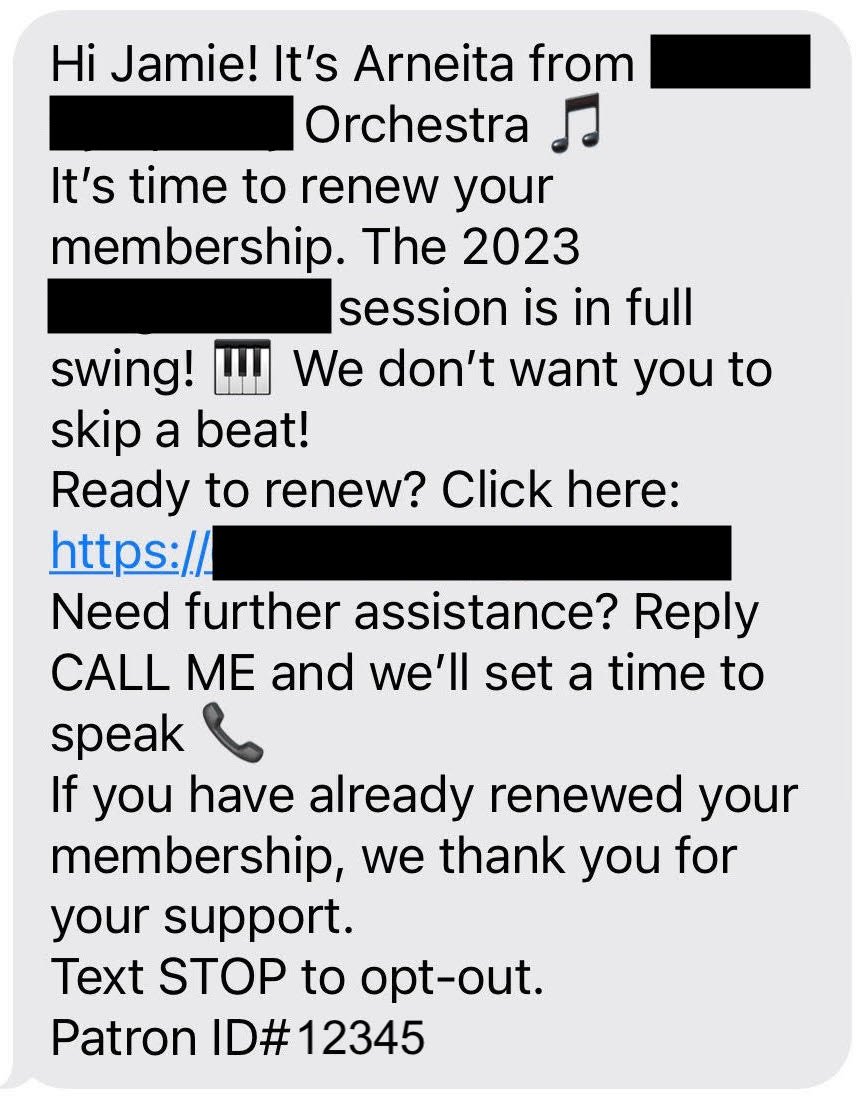Texting Boosts Membership: An Orchestra Case Study
The Challenge
During a successful outbound calling campaign focused on building membership, a major symphony orchestra was eager to reach those who had not responded to phone calls and other outbound efforts. The orchestra compiled a list of several thousand households, representing a diverse mix of donors and ticket-buyers, to test a peer-to-peer texting initiative for the first time.
The Solution:
Cell Phone Verification: The initial step involved verifying cell phone numbers to ensure they were SMS-capable. Approximately 50% of the numbers were confirmed as valid, saving resources and boosting efficiency.
A Personal Touch: By utilizing peer-to-peer texting, each message was personalized and sent by a DCM representative. Messaging offered a scheduled call-back option, making it clear that a human being was ready and available to help as needed.
Friendly Tone & Easy-to-Use: Messages were thoughtfully crafted with a friendly tone. They included a straightforward call-to-action link to the organization's online membership form, making it as easy as possible to make a gift.
Targeted Messaging: DCM grouped a complex mixture of renewing members, lapsed members, and ticket-buyers into similar batches, enabling us to deliver tailored messaging for each group efficiently.
The Results:
Membership Gifts: Over the course of a few short weeks, the texting initiative yielded 14 membership gifts, including 10 renewals and 4 new memberships, all generated through the tracked web link.
High Return on Investment: Revenue exceeded $3,500, representing over a 200% return on investment*.
Strong Response Rate: In addition to 14 memberships, the campaign generated many additional responses, which were often requests for more information or a direct call with the orchestra’s staff. DCM’s representatives responded in real-time to questions and requests.
Standard Opt-Outs: Renewal segments experienced the lowest opt-out rates and strong engagement. While the rate was slightly higher for acquisition segments, this is typical for a first-time texting campaign. In the future, we expect the opt-out rate to stabilize at approximately 2-4%.


The Conclusion:
Cultivation is Key: Texting serves not only as a fundraising tool but also as an avenue for nurturing donor and ticket buyer relationships. Maintaining high-quality service ensures that patrons feel valued and engaged.
Low-Cost, High Return: Peer-to-peer texting stands out as a cost-effective method with low costs that delivers a strong return on investment.
Reach Donors Where They Are: Texting is a ubiquitous form of daily communication for most Americans, making it an essential channel for reaching patrons who may not respond to other channels.
Keep it Simple: Simplicity and brevity are vital. Providing a direct link to the membership form kept the interaction straightforward and effective.
Replies Outperformed Opt-Outs: As with any new initiative, you don’t want to rock the boat with your existing audience. This initiative yielded more replies than opt-outs, indicating that this mode of communication is not only acceptable but welcomed.
The orchestra's venture into peer-to-peer texting not only boosted membership and revenue but also highlighted the importance of fostering relationships with patrons. Integrating this approach with calling created the option for a more personalized connection that aligns with donors’ preferred means of communication. Consequently, the organization is now implementing texting on a monthly basis as a complement to its outbound phone calls.
Studies consistently show that multiple approaches improve results across all channels. Each additional touchpoint in a donor's journey generates a ripple effect, regardless of their direct response to a given approach. Peer-to-peer texting offers a cost-effective touchpoint for organizations looking to enhance their fundraising and marketing efforts through thoughtful, donor-centric communication with a personal touch.
Notes:*Return on Investment = (Revenue - Initial Cost)/Initial Cost

